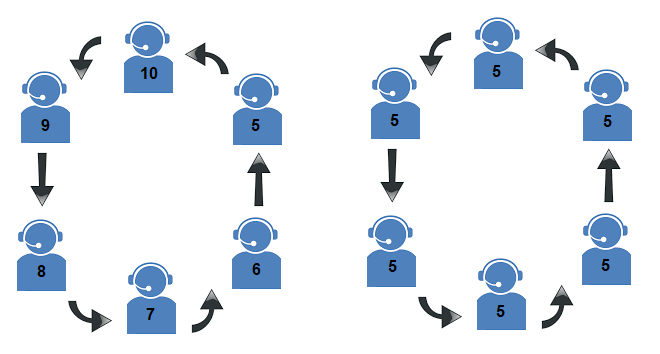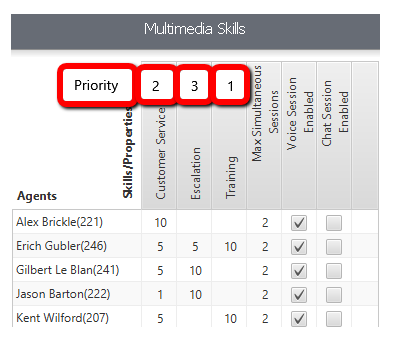Contact Center (Multimedia) Routing Algorithms
When building a skill group there are five different routing algorithms to choose from. Each of them is explained below.
Most Idle
Calls are presented to the agent who has been idle the longest. An agent is considered to be idle when they are logged into their extension and not currently involved in any phone activity. Not Ready (NR), DND, and Skill Group Login are not factored into idle duration.
Circular
Calls are presented to agents in a circular manner. The skill set can be used as a starting point as shown on the left. The agent with the highest skill would receive the first call and from there it would rotate circular between the agents. If agents have the same skill set as shown on the right, calls will rotate circular between the agents alphabetically. Each new call will be offered to the next agent in the circular order based on who was presented the last call.

Linear
Calls are presented to a list of agents from top to bottom, depending on the skill set. Agents with the highest skill set will always be presented with new calls first. If agents have the same skill set, the routing algorithm uses most idle among the similarly skilled agents and the call is presented to the agent with the longest idle time first.

Intelligent Highest Skill First
Overview
Intelligent Highest Skill First will use advanced logic to determine who the call should be delivered to based off of the ranking of an agent in this skill and the membership of the agent in other skills. The following steps are taken to create a prioritized list, the top of which will be presented a call if available.
- Check the skill level of each available agent and deliver to the agent with the highest skill level. If there is a tie, go to step two.
- For each agent, calculate who has the least collateral damage among other skill memberships. This is done by multiplying each skill by the priority of that skill, then adding those numbers together. A mathematical formula would look like (Skill A Priority x Agent Rank in Skill A) + (Skill B Priority x Agent Rank in Skill B Level) + (Skill C Priority x Agent Rank in Skill C) etc... If there is a tie, go to step three.
- Who among the remaining agents has been idle longest. If there is a tie, go to step four.
- Select between the remaining agents at random.
Below are some examples of how this algorithm will handle call routing for each scenario.
Scenario A: Everyone is idle and a call comes into the Customer Service skill.
Scenario B: Everyone is idle and a call comes into the Escalation skill.
Scenario C: Everyone is idle and a call comes into the Training skill.
Example One

Scenario A:
- All agents have a skill of 10, so they are all equally ranked at this point.
- Erich, Gilbert, Jason, and Kent are all a part of other skills. Below is the formula for each agent:
a. Alex: Not a member of any other skill, so (0 x 0) = 0
b. Erich: Training priority 1, skill level 10, so (1 x 10) = 10
c. Gilbert: Escalation priority 1, skill level 10, so (1 x 10) = 10
d. Jason: Escalation priority 1, skill level 10, so (1 x 10) = 10
e. Kent: Training priority 1, skill level 10, so (1 x 10) = 10
At this point we discover that Alex offers no collateral damage, so we present the call to Alex.
Scenario B:
- Gilbert and Jason are the only members of the Escalation skill, both with the rank of 10.
- Gilbert and Jason are also members of the Customer Service skill. Therefore:
a. Gilbert: Customer Service priority 1, skill level 10, so (1 x 10) = 10
b. Jason: Customer Service priority 1, skill level 10, so (1 x 10) = 10
c. Since both agents offer an equal amount of collateral damage, we proceed to step three. - Gilbert has been idle for five minutes and Jason has been idle for three minutes.
Since Gilbert has been idle longer than Jason, the call is presented to Gilbert.
Scenario C:
- Erich and Kent are the only members of the Training skill, both with the rank of 10.
- Erich and Kent are also members of the Customer Service skill. Therefore:
a. Erich: Customer Service priority 1, skill level 10, so (1 x 10) = 10
b. Kent: Customer Service priority 1, skill level 10, so (1 x 10) = 10
c. Since both agents offer an equal amount of collateral damage, we proceed to step three. - Erich has been idle for two minutes and Kent has been idle for four minutes.
Since Kent has been idle longer than Erich, the call is presented to Kent.
Example Two

Scenario A:
- Alex has the highest skill in Customer Service.
Since Alex has the highest skill, he is presented the call.
Scenario B:
- Gilbert and Jason are the highest skilled members of the Escalation skill, both with the rank of 10.
- Gilbert and Jason are also members of the Customer Service skill. Therefore:
a. Gilbert: Customer Service priority 2, skill level 5, so (2 x 5) = 10
b. Jason: Customer Service priority 2, skill level 1, so (2 x 1) = 2
Sending a call to Jason creates the least collateral damage, so he will be presented the call.
Scenario C:
- Erich and Kent are the only members of the Training skill, both with the rank of 10.
- Erich is a member of the Customer Service and Escalation skills, while Kent is a member of the Customer Service skill. Therefore:
a. Erich: Customer Service priority 2, skill level 5; Escalation priority 3, skill level 5; so (2 x 5)+(3 x 5) = 25
b. Kent: Customer Service priority 2, skill level 5, so (2 x 5) = 10
Sending a call to Kent creates the least collateral damage, so he will be presented the call.
No Routing Algorithm
This routing algorithm is reserved for IVRs and will not automatically route to any agents until a menu selection is made. After the caller has made a selection, the call will be routed to another group which can route the call using its own routing strategy.
Updated 2 months ago